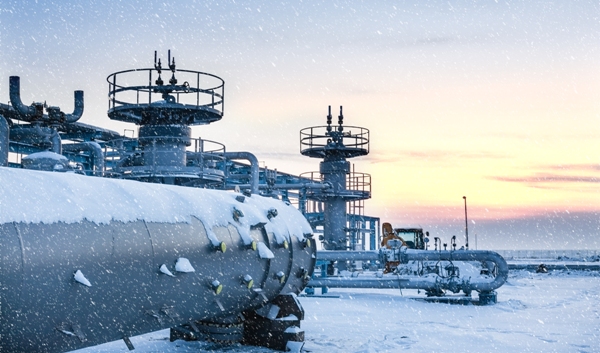
Weather services can give you a heads up about a cold front, but can’t predict how winter will affect your refinery. Protect your refinery operations from freeze-up by taking prevention and control steps. Plan as if freeze-ups were a certainty. Whether you are in Fort McMurray (or Siberia) or farther south in Tulsa and rarely experience severe cold, you are at also the risk. The consequences can be severe.
Freeze prevention and mitigation begins with a carefully drawn freeze plan. Make sure your cold-weather winter action plan includes:
- A schedule for preparing process units and buildings prior to the cold weather season.
- A weather watch with procedures for alerting management and maintenance personnel.
- An arrangement for maintenance personnel to be available. Have Emergency Response Team (ERT) members patrol the area in search of cold spots, structural damage or piping leaks.
- Procedures for repairing or replacing damaged equipment and for restoring fire protection as safely and quickly as possible
- Have procedures to monitor and maintain adequate heat, especially if temporary shutdown becomes necessary.
Winter Weather Checklist
Be Prepared! When preparing for a possible winter storm or freeze, use this checklist to minimize your refinery’s exposures. Instituting the following precautions, before, during and after a storm or freeze-up can help mitigate the severity of the loss as well as enhance the overall safety of the refinery.
This first post will deal with Pre-storm precautions and the next post with cover what to do during the cold weather.
Pre-storm precautions
General
- Gather emergency supplies: portable heaters for staff and instrument sheds, antifreeze supplies and warm clothing.
- Prepare snow removal equipment, trucks, blowers, shovels
- Establish priorities for steam usage, steam hose and lance for thawing frozen lines. Provide an adequate steam-tracing or electric-training system.
- Train ERT
- Test alarms that monitor power supply, temperature, low-water fuel trips on boilers, water temperature on exposed water-storage tanks, and process controls.
- In susceptible areas, drain in advance or add antifreeze.
- During maintenance, limit electrical panel shutdown to only the minimum required to be off.
Buildings
- Ensure building integrity and check insulation. Identify concealed space that has vulnerable piping.
- Design heating and insulation systems to maintain minimum 40 F (4C) temperature. Do you have an alternate energy source in case of interruption?
Equipment and Structure
- Replace insulation after making repairs.
- Have a plan for removing ice from pipe racks.
- For boilers: Drain idle equipment completely, check drain valves, provide steam traps, remove dead ends, consider heat-tracing lines
- Provide alarms for important piping systems.
- For pumps and compressors and other water-cooled equipment provide adequate heat or antifreeze solution. Don’t forget the methanol injection pumps. Use lubricant for low temperature application.
- For water-filled instrumentation and control lines: provide heat tracing and insulation
- For idle air-conditioning remove water from oil cookers and water jackets and drain condensers of chilling units.
- Check pressure-vessel vents, relief valves and safety valves to assure moving parts are protected from water accumulation or vapor freezing.
- Check dryers on instrument air systems.
Fire Protection
- Monitor temperature in buildings with sprinkler systems
- Maintain pump room temperature
What else should we add to the list? What is in your procedures to prepare you for the next polar vortex?








Great Suggestions, Paul!
READERS – What does your site do to stay safe and productive during the cold weather? Add your best suggestions and comments here for a chance to win!
Cold Weather Action Plan Part II
During Cold Weather
The consequences of cold weather at your refinery can be severe. The previous blog explained preparing for winter with a pre-storm precautions checklist. This post will list specifics to deal with during cold weather.
Winter Weather Checklist
During Cold Weather
Develop a list of emergency phone numbers of weather forecasters and contractors, and appoint someone to monitor weather reports.
Monitor and record temperature in areas that contain vulnerable equipment, repeat every few hours during particularly cold weather.
Check temperature during critical areas on nights and weekends, as well as during the day by using alarms and a continuously touring watch service.
Check heat tracing to make sure they are working properly.
Drain water cooled equipment that has not been otherwise protected.
Drain condensed moisture from compressed air lines frequently.
If an area should completely lose heat:
1. Drain the equipment listed below:
• Process piping
• Heat exchangers
• Process equipment
• Compressors
• Water-cooled jackets
• Condensate piping
• Boilers
• Hydraulically operated devices
• Air-conditioning systems
2. Institute emergency procedures for processes that are dependent on a steam or water supply
3. Drain piping systems that contain liquid other than water that are vulnerable to freeze-ups
4. Check pressure-vessel vents and relief and safety valves for frost or ice.
What have you experienced with your cold weather operations?